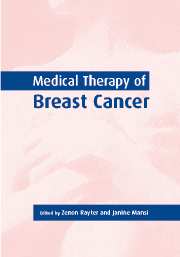Book contents
- Frontmatter
- Contents
- List of contributors
- 1 History of breast cancer therapy
- 2 Chemoprevention of breast cancer
- 3 Familial breast cancer
- 4 Hormone replacement therapy and breast cancer
- 5 Screening for breast cancer
- 6 The management of in situ breast cancer
- 7 Adjuvant systemic therapy
- 8 Adjuvant radiotherapy in the management of breast cancer
- 9 Predictors of response and resistance to medical therapy
- 10 Primary medical therapy in breast cancer
- 11 Medical therapy of advanced disease
- 12 Experimental approaches
- 13 The place of bisphosphonates in the management of breast cancer
- 14 Palliative care in breast cancer
- Index
8 - Adjuvant radiotherapy in the management of breast cancer
Published online by Cambridge University Press: 06 January 2010
- Frontmatter
- Contents
- List of contributors
- 1 History of breast cancer therapy
- 2 Chemoprevention of breast cancer
- 3 Familial breast cancer
- 4 Hormone replacement therapy and breast cancer
- 5 Screening for breast cancer
- 6 The management of in situ breast cancer
- 7 Adjuvant systemic therapy
- 8 Adjuvant radiotherapy in the management of breast cancer
- 9 Predictors of response and resistance to medical therapy
- 10 Primary medical therapy in breast cancer
- 11 Medical therapy of advanced disease
- 12 Experimental approaches
- 13 The place of bisphosphonates in the management of breast cancer
- 14 Palliative care in breast cancer
- Index
Summary
Introduction
Adjuvant radiotherapy (RT) has an established role in the reduction of risk of locoregional breast cancer recurrence, both postmastectomy and after breast-conserving surgery (BCS). Importantly, results of recent clinical trials also suggest that locoregional RT may impact on overall survival, adding to the benefits accruing to systemic adjuvant therapy. This chapter will review the evidence base for current recommendations for adjuvant RT, highlight areas of ongoing research activity and indicate directions for future treatment optimization.
Radiotherapy and breast conservation
The aims of breast-conservation therapy using tumorectomy and adjuvant radiotherapy are to ensure survival equivalent to mastectomy, whilst optimizing the cosmetic outcome and minimizing risks of disease recurrence in the conserved breast. Since the 1970s, there have been six prospective randomized trials in which breast-conserving surgery has been compared with mastectomy. These studies have confirmed the efficacy of BC + RT with respect to survival (Table 8.1). Differing surgical and RT techniques lead to varying rates of recurrence in the breast from 4% to 20% at 10 years. Importantly, despite undergoing a more radical surgical procedure, associated with significant rates of psychosexual morbidity, it was observed that mastectomy still conferred a risk of local recurrence of 2–9%.
As a result of these randomized studies, and many retrospective large single-centre studies of BCT and RT, this approach has become the standard of care for women who wish to opt for BCT.
- Type
- Chapter
- Information
- Medical Therapy of Breast Cancer , pp. 178 - 208Publisher: Cambridge University PressPrint publication year: 2003



